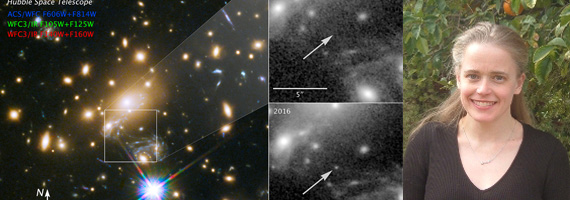
Steward Observatory Astronomer Helps Find Distant Star
Hubble Opens Door to New Field of Cluster Lensing
A group of astronomers including Assistant Professor Brenda Frye, LBT Staff member David Thompson, MMT Staff Astronomer Ben Weiner, and Steward Associate Professor Nathan Smith were able to see a luminous blue supergiant (a "normal star") in an object 9 billion light years of light travel time away. The reason that the Hubble Space telescope was able to image this star was because of gravitational lensing, with a boost of a factor of 2000 in brightness, as this star passed through a cusp in the gravitational lens. Two science stories can be seen HERE and HERE.
Brenda has graciously agreed to tell us the story, which follows:
"Four years ago, the Hubble Space Telescope (HST) observed the first case of the image of a single exploding star that appeared in four different locations as a result of an optical effect called gravitational lensing. This is where the strong collective gravity of a cluster of galaxies can bend and magnify light from background objects, acting like a huge lens. Intrigued by this discovery, team leader Prof. Pat Kelly from the University of Minnesota and UA astronomer Prof. Brenda Frye raced to request follow-up observations through Discretionary time of the Director of the Large Binocular Telescope Observatory (LBTO) Dr. Christian Veillet. Of the telescope holdings at Steward Observatory, one reason LBTO is special is for its high resolution imaging using adaptive optics which corrects for the turbulent effects of Earth's atmosphere. Images were acquired at near-infrared colors of the spectrum outside of the visual range, and also beyond the reach of HST, by Frye and UA LBTO staff astronomer Dr. Dave Thompson. The image yielded only an upper limit on the flux. These data together with other imaging data at different wavelengths enabled its identification as a supernova.
Suddenly, in 2016, a new point of light was spotted by HST a mere 5 arcseconds from the quartet of supernova images. UA astronomer Dr. Ben Weiner helped to secure observations using HST that showed that this new source became more than three times brighter in one month. The team at first thought that they had found another supernova. Instead, with the help also of UA astronomer Prof. Nathan Smith, we realized that we had instead discovered a rare blue supergiant star. This type of star is much larger, more massive, hotter, and possibly hundreds of thousands of times intrinsically brighter than our Sun. But at 9 billion light years away, the star would still be too distant to be detected by any telescope on its own. Importantly, the additional boost in brightness by a factor of 2000 happened as a result of the star passing through a critical location in the lens that made it only appear to be much brighter. Thereafter, the light is expected to fade as it moves past this point, much like when Icarus of Greek mythology experienced only fleeting glory as he flew too close to the Sun. That is why we chose to name this new lensing event, "Icarus."
To add to the complexity, in May of 2016, Icarus actually had two peaks in brightness. This may mean it’s not a single star, but rather two luminous stars orbiting around one another! That would be another first—not only the farthest star, but also the farthest binary star system. The discovery of Icarus through gravitational lensing has opened the door as to a way for astronomers to study individual stars in distant galaxies. When NASA's James Webb Space Telescope is launched, astronomers expect to find many more stars like Icarus. This second study was also led by LBTO partner Prof. Pat Kelly."

For Public
Public events include our Monday Night Lecture Series, world-reknowned Astronomy Camp and Mt Lemmon Sky Center.

For Students
A good place to start if you want to become an undergrad major or grad student, or need to find our schedule of classes.

For Scientists
Find telescopes and instruments, telescope time applications, staff and mountain contacts, and faculty and staff scientific interests.




